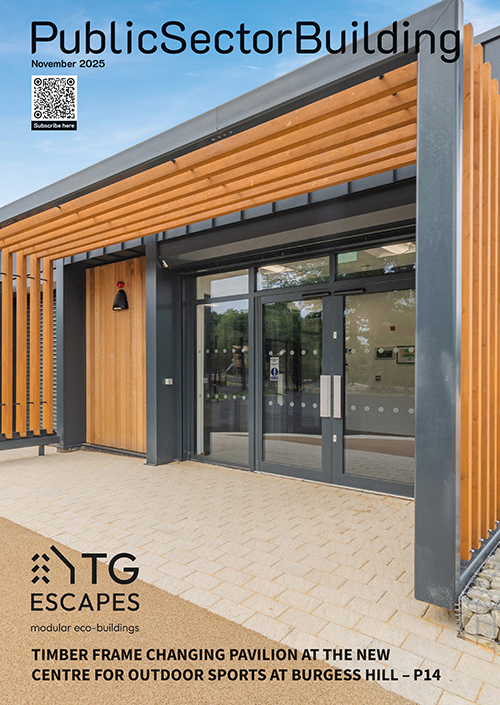Not all conversion projects that sub-divide a house or other building into two or more domestic dwellings will involve creating upper and lower floor self-contained flats. Another approach is to divide vertically, so, for example, a large detached house becomes two semi-detached houses. Hush Acoustics has more…
But in order to create properties that meet the Building Regulations, the new party wall that will separate the two side-by-side properties will have to be constructed in a way that meets minimum acoustic standards. Approved Document E covers England & Wales and demands that a separating wall has a minimum airborne sound transmission level of 43 dB DnTw+Ctr.
With this calculation, the higher the figure the better, so 43 should be regarded as the compliance level – if you strive for higher figures, the sound reduction capability of the party wall will be better.
In Northern Ireland, the minimum performance level is the same and it uses the same calculation, but in Scotland Section 5 of the technical handbook specifies two figures according to the type of building and a different calculation method is used.
A ‘traditional building’ requires a minimum standard of 53 dB DnTw, but for all other types of building the party wall will need to achieve 56 dB DnTw or above. Note here that there is no ‘+Ctr’ – this is an adjustment applied to the performance figures in England, Wales and Northern Ireland to account for low frequency noise such as bass which is much harder to insulate against.
Why do we have these minimum acoustic performance levels for party walls?
In short, all domestic dwellings are designed to ensure the occupiers – usually homeowners or tenants – can expect a certain level of insulation against sounds from neighbouring properties connected to theirs. It is not just about the separating walls – ceilings and floors must be treated in the same way in the case of multi-storey flats.
This is to provide a decent quality of life inside our homes, part of which is being able to live without excessive noise from adjoining properties, and help to prevent health issues. Numerous studies from around the world have concluded that there is a link between nuisance noise and ill-effects on some people. This can lead to stress, amongst other things, that can result in numerous mental and physical health problems ranging from heart disease to depression.
Hence, why it is vital to get the separating wall’s acoustic specification right. But it is not only about compliance – acoustics best practice is to go above and beyond the minimum standards wherever possible as the capabilities of today’s sound reduction systems and products can deliver far better performance. An update to the Building Regulations is long overdue, which is illustrated by that fact the Approved Document E has not changed significantly since it was first published in 2003 – the year before Facebook was launched!

Transforming an internal wall into a party wall – meeting the acoustic standards
Step 1: Assess the potential for upgrading an existing wall
Depending on how you propose to split the house, the new layout may lend itself to retaining an existing wall that is currently an internal wall between rooms, such as between two bedrooms, and turning this into the new party wall.
If this is the case, an effective sound insulation treatment will need to be applied – so establish what the existing construction is. Is it a timber stud, brick or block/masonry or something else?
The reason why this assessment is needed is because sound transmits differently through different materials. The design of the acoustic upgrade, therefore, will need to consider factors including the density of the materials and the thickness.
Step 2: Determine the maximum loss of room space that can be lost
The wall thickness will almost always need to be increased to accommodate sound insulation. So, this needs to be factored in to the proposed design of the rooms adjoining the new party wall, because the available floor space in both new houses will be reduced as a result.
In general terms, the thicker the party wall, the better the acoustic performance will be. If the target level of soundproofing is higher than the compliance standard, therefore, this may not be achievable if the depth of the wall lining system is restricted. It is important to decide early-on, therefore, what is the maximum depth you are prepared to accept to design a solution – is it 50mm, 100mm or 150mm, for example?
Step 3: Assess the floor to establish if this also needs an acoustic upgrade
The design and materials used for the existing floor will also need to be considered because airborne sound will transmit through walls using any available sound paths – and that includes structures and materials that are joined to it. Unless the floor structure is considered, therefore, even the highest performing acoustic treatment used for the party wall would be undermined.
The assessment must look at what the existing floor structure is within the property and how the floor construction ties in with the wall as it stands. Doing this will reveal whether there are potential sound paths to be addressed.
The potential for impact sound transmitting through the floor will also need to be considered in party wall soundproofing. The floor construction may need to be enhanced using rubber based materials as these are effective at preventing impact noise transferring into the party wall.
Step 4: Assess impact noise risk from staircases
If there is a proposal for staircase to be attached to what will become the new party wall, the acoustic implications will need to be considered to design-out sound paths. It may be that there is an existing staircase that will need be retained in one of the properties, in which case an upgrade will be needed, but if not, a better approach may be to consider locating a new staircase elsewhere in the properties if possible.
Why does this matter? Impact noise from stair travelling into party walls can cause serious problems for the occupants of adjoining houses as they go about their day-to-day lives. Impact sound needs to be addressed differently to airborne sound which usually means adding rubber based materials capable of absorbing the thudding of footsteps.
Step 5: Consider how to deal with services running in the new party wall
Sound paths can also be created as a result of services running through any separating wall, floor or ceiling. This is can often stem from incorporating features such as socket boxes and light switches into the party wall.
Issues can be easily avoided, however, if an effective sound insulation treatment for these elements is designed-in early, rather than leaving it to chance by outsourcing these decisions to electrical contractors or other trades who may not understand the consequences of their decisions and your efforts to prevent the passage of sound.
Step 6: Check for infill areas and design for acoustic consistency
Consider how to deal with infilled doorways and other gaps when creating the party wall. It may be that the internal wall earmarked to become the new party already features a doorway or several, in which case they will become infill areas once they are part of the new wall and require special treatment.
Where possible, be consistent with the materials used to fill this area so the construction can offer the same density and performance as the rest of the existing wall. In a similar vein, take care not to overlook doorways that may have been closed-up in the past too, as they could end up being a part of the wall that offers significantly lower levels of sound insulation.
Step 7: Determine how the proposed layout of the newly created properties may cause acoustic issues
Is your proposed layout or each of the newly created properties going to cause noise problems for residents?
Before you confirm the floorplans and room layout, consider whether the proposed arrangement of rooms inside each of the newly created houses is optimised acoustically. For example, if your design is proposing a bedroom to bedroom situation at either side of the party wall, consider increasing the acoustic performance of the party wall, depending on whether you feel that the minimum standards are sufficient or if you want the wall to perform better.
Expert guidance from Hush Acoustics
As the step-by-step process for this particular application demonstrates, building soundproofing is a multi-dimensional topic which requires an attention to detail to deliver the right results. Cutting corners or accidentally missing a potential sound path can lead to costly consequences should the property fail a sound test, both in terms of the cost of remedial work and delays in the house being marketed for sale or rent.
If you are working on a property to convert a single dwelling or commercial building into two or more self-contained homes, Hush Acoustics can provide specialist acoustic advice to help ensure the specification will meet the requirements of the Building Regulations and maximise the level of sound insulation possible given the project criteria.
To find out more visit www.hushacoustics.co.uk




